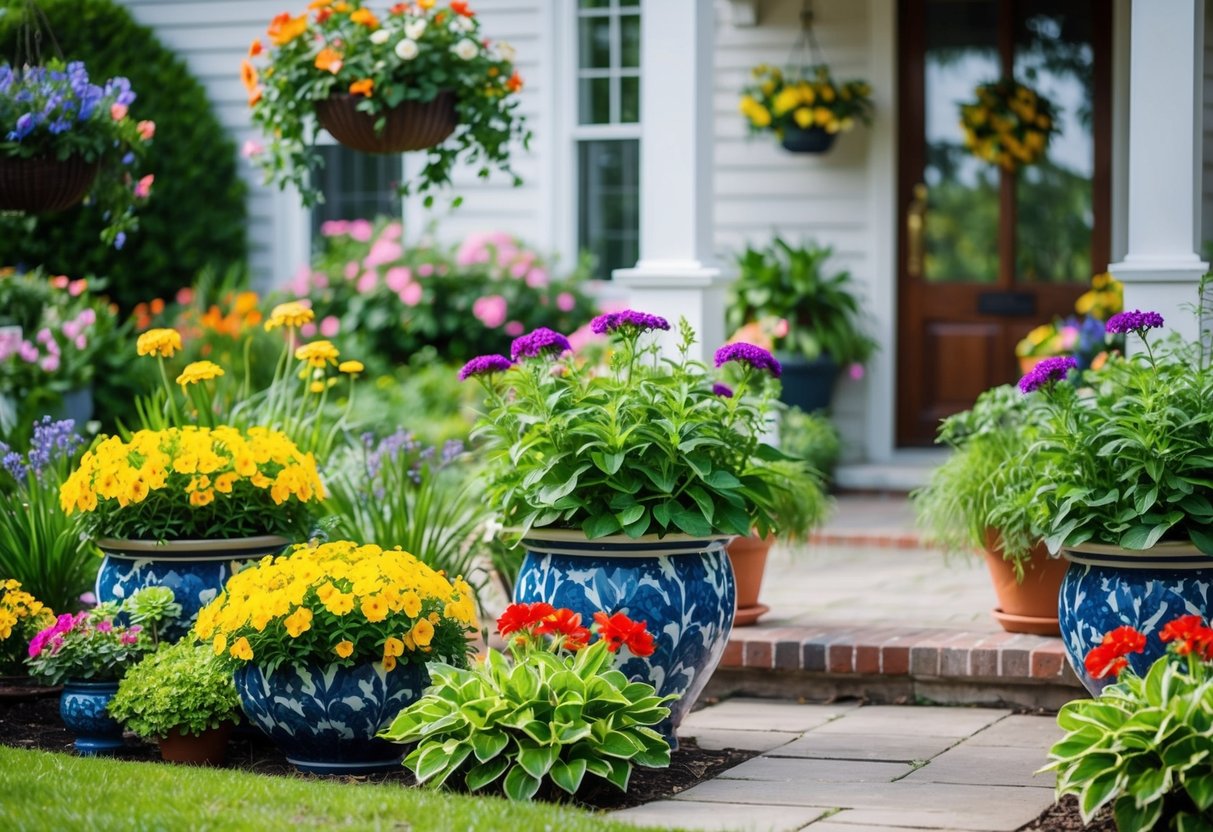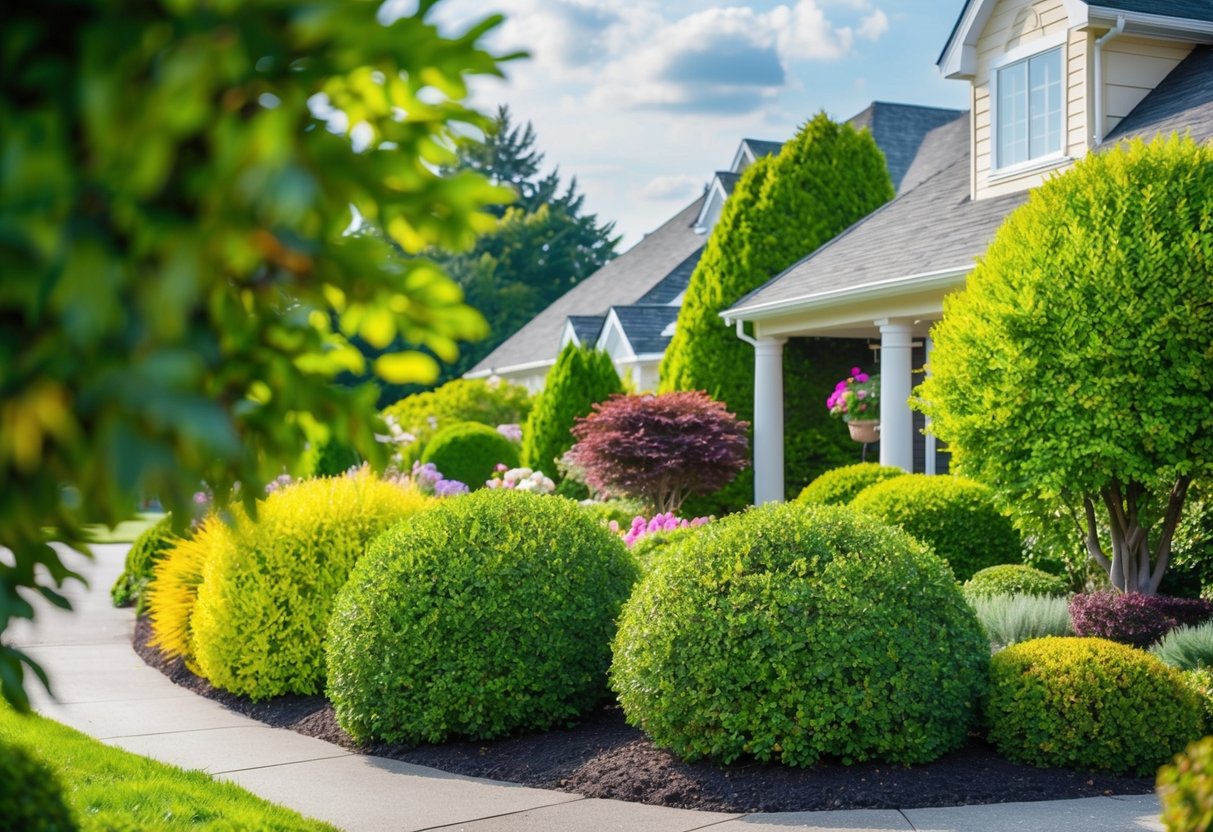What are the Best Decorative Plants for the Front Garden? Top Picks and Tips
Transforming your front yard into a beautiful garden is a great way to boost your home’s curb appeal. You want plants that are not only decorative but also suited to your yard’s environment. Bar Harbor juniper can be a perfect choice, thanks to its ability to thrive in full sun and different soil types. Its blue-green foliage can provide a lovely contrast to your house’s colors.

Another option for your front yard landscaping is the dwarf spirea shrub. These low-growing flowering plants add a splash of color with blooms ranging from white to deep pink. They’re easy to maintain and can fit well in front-of-the-house gardens.
For a touch of greenery and white flowers, consider ‘Emerald Snow’ loropetalum. This evergreen grows up to 6 feet tall and 4 feet wide, making it ideal for some shade and coverage in your garden. It flourishes in full to part sun and prefers acidic, well-drained soil. With these choices, your front yard landscape can become a welcoming and vibrant space.
Choosing the Right Plants for Your Front Garden

Selecting the best plants for your front garden involves understanding soil conditions, sunlight exposure, plant hardiness, and how much maintenance you are willing to provide. The goal is to create a garden landscape that flourishes and complements your home.
Understanding Soil Types and Sunlight
The type of soil in your garden plays a big role in plant selection. You might have clay, sandy, or loamy soil, and each supports different types of plants best. For instance, well-drained soil is ideal for drought-tolerant plants. Testing your soil can help you decide which plants will thrive.
Sunlight is another key factor. Knowing whether your garden area gets full sun, partial sun, or light shade will guide you. Some plants need full sun all day, while others do well in shaded areas. Make sure to match your plant choices with the sunlight conditions in your garden landscape for the best results.
Considering Plant Hardiness and Maintenance
Choosing plants within your local USDA hardiness zone ensures they can survive the weather in your area. Check the zone ratings of potential plants to see if they are suitable. This helps in picking durable plants for the climate.
You should also consider how much maintenance you’re prepared to do. If you want less gardening work, look for low-maintenance plants that require minimal care. Some may only need periodic trimming or regular watering. Others might require more attention, but they can become stunning focal points in a landscaping plan with a little extra effort.
Essential Decorative Shrubs and Bushes

Choosing the right shrubs and bushes can transform your front garden into a beautiful landscape. Evergreen shrubs provide year-round greenery, while flowering shrubs add colorful blooms.
Evergreen Shrubs for Year-Round Appeal
Evergreen shrubs are perfect for keeping your garden lush throughout the year. These plants retain their leaves in all seasons, ensuring your garden stays vibrant even in winter. Boxwood shrubs are a popular choice because of their dense foliage and manageable size. They work well in formal gardens and can be shaped easily through pruning.
Yew shrubs are another excellent option. They have dark green needles and tolerate a range of conditions, making them versatile for different landscapes. These shrubs are ideal for creating borders or hedges.
If you’re looking for an evergreen that blooms, consider planting an evergreen flowering shrub. Rhododendrons, for example, produce stunning clusters of flowers and thrive in shaded or semi-shaded areas. These shrubs not only give you lush foliage but also offer a splash of color in spring.
Flowering Shrubs for Colorful Displays
Flowering shrubs can create eye-catching displays with their bright and varied blooms. Hydrangeas are a favorite choice, known for their large, showy flowers. They bloom from early spring to early fall and are available in beautiful shades like pink, purple, and blue. These shrubs are also easy to maintain, making them a hassle-free addition to any garden.
For a burst of color and fragrance, consider azaleas. These flowering shrubs have vibrant, colorful flowers and thrive in well-drained soil. They can be used to accent parts of your garden or create stunning focal points.
If white flowers are more your style, Rhododendron ‘Dora Amateis’ produces lovely white blooms that can add elegance to your garden. Each of these flowering shrubs offers unique beauty, allowing you to craft a garden that reflects your personal style.
Spectacular Flowering Plants for a Splash of Color

Adding vibrant flowering plants to your front garden can greatly enhance its visual appeal. You can choose from both perennials and annuals for variety and interest, while classic options like roses provide timeless beauty.
Selecting Perennials and Annuals
When planning your flower beds, consider using a mix of perennials and annuals. Perennials like viburnum are a great choice because they return year after year, offering long-lasting color. These plants can form the backbone of your garden landscape.
Annuals, on the other hand, must be replanted each year but provide bright and bold colors. They are perfect for filling in gaps between perennials and adding fresh blooms. By choosing a variety of colors and bloom times, you can have flowers throughout the growing season.
Consider a flower bed idea with layers of different heights. Taller perennials at the back can create depth, while shorter annual flowers bring vibrancy to the forefront. This strategy ensures that your garden always has something exciting to offer. Don’t forget to deadhead spent blooms regularly to encourage more flowers and keep the plants looking tidy.
Roses and Their Cousins for a Classic Look
Roses are a timeless addition to any front garden. Shrub roses and rose bushes come in many colors and types, offering flexibility in your garden design. Climbing roses can cover walls or trellises, adding height and elegance to your landscape.
When selecting roses, think about your garden’s size and sun exposure. Most roses love the sun, so make sure they get plenty of light. Regular pruning and deadheading are important to keep them healthy and blooming profusely.
For a coordinated look, pair roses with their botanical cousins, like flowering quince. This combination can provide a harmonious feel while ensuring that your flower beds have continuous blooms. By choosing the right varieties and caring for them well, you can enjoy their beauty throughout the season.
Adding Structure with Trees and Ground Covers

In small gardens, adding structure with trees and ground covers can maximize space while enhancing beauty. Compact trees provide height, while ground covers fill in gaps and add texture.
The Importance of Structure in Small Spaces
In compact spaces, structure is crucial. Dwarf trees like the Dwarf Korean Lilac and Dwarf Alberta Spruce provide vertical interest without overwhelming your garden. These trees add height, making your garden feel larger and more organized.
Using compact shrubs and low-growing varieties can create layers and define zones. This approach helps you manage space effectively, ensuring that each plant has its place. Choose plants that suit your environment, considering sunlight and soil conditions.
Compact shrubs work well for defining borders or small garden sections. They make maintenance easier, giving a neat and tidy appearance. These plants are perfect when you want to balance aesthetics with functionality.
Ground Covers to Complete the Look
Ground covers are essential for filling gaps and adding texture. They help reduce maintenance by suppressing weeds and retaining moisture. Plants like English Lavender are not only beautiful but also practical.
Hostas are another excellent choice, offering lush greenery and variety in leaf shape and color. They thrive in the shade, making them ideal for areas under trees. Grasses can add movement and texture, providing a natural, flowing look to your garden.
By choosing the right ground covers, you enhance the overall structure of your garden. They complete the garden’s appearance, making it a harmonious and inviting space. Consider your local climate and garden conditions to select the best options.
Accentuating Your Front Garden with Accessories

To make your front garden more inviting and beautiful, consider adding accessories that add character and charm. These enhancements can improve curb appeal by integrating various elements that complement decorative plants.
Walkways, Trellises, and Containers
Create defined paths with walkways to guide visitors through your garden. Using gravel or stone can add texture and contrast while being both functional and attractive. Walkways help separate flower beds and make your garden more organized.
Incorporate trellises to add height and interest. They work well with flowering bushes and climbing plants, providing support and visual appeal. Consider placing window boxes filled with vibrant flowers to enhance your home’s exterior and create a welcoming view.
Containers are versatile as well. Large decorative pots can hold a variety of plants, adding layers of color and providing flexibility. You can move them around to suit your needs or seasonal changes.
Incorporating Natural Elements
Use natural elements like rocks and wood to blend seamlessly with the environment. Strategically placed stones or rock arrangements can emphasize certain areas, such as flower beds or borders. They also help maintain an earthy tone throughout your garden.
Introduce water features, like a small fountain or birdbath, for a calming effect. This can attract wildlife, adding life and movement to your space.
Adding rustic wooden features, such as benches or arbors, can provide functionality and style. These elements create a cozy feel and encourage relaxation in your garden.
The harmonious combination of these natural elements with accessories can transform your front garden into a peaceful oasis.







